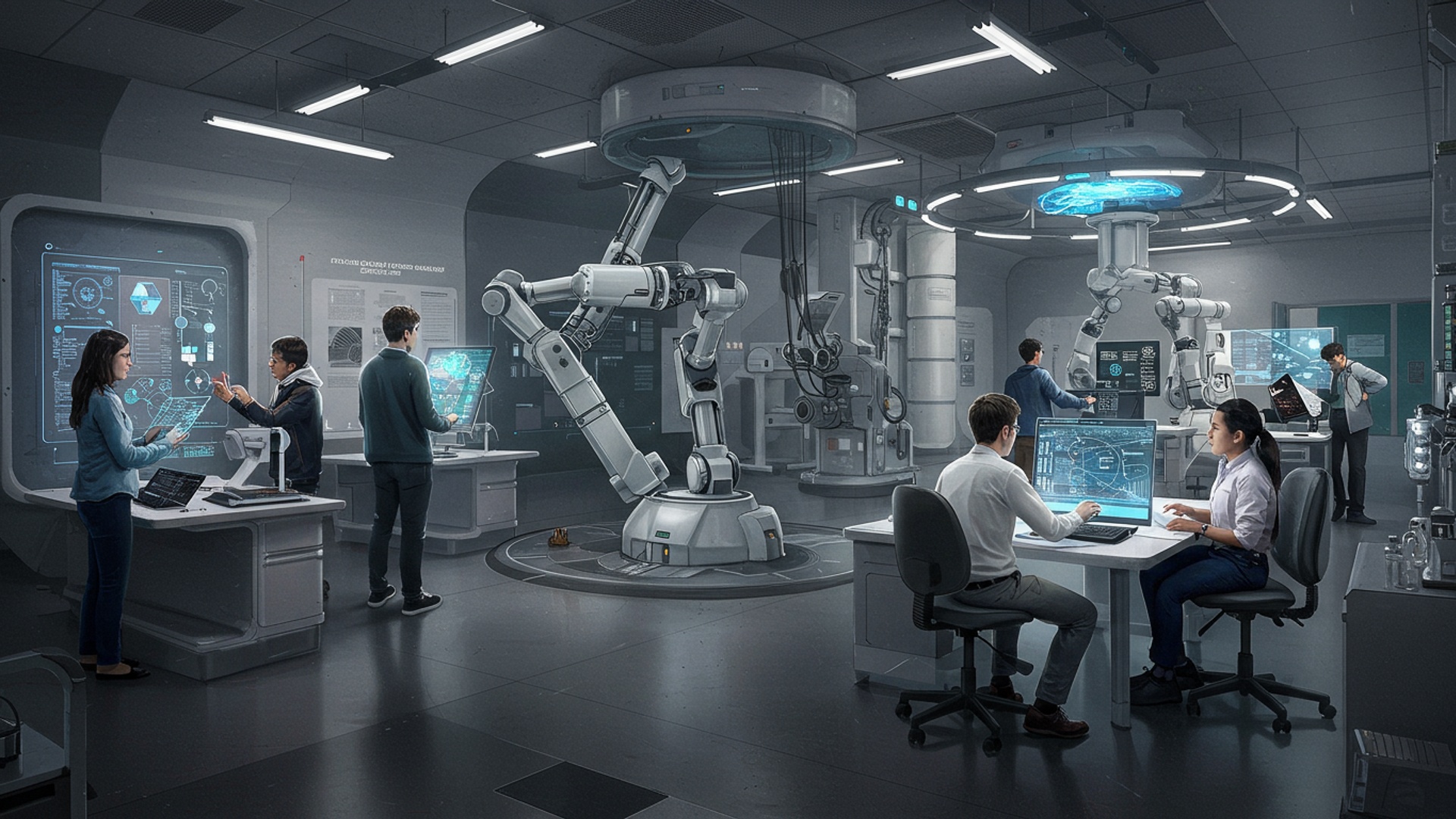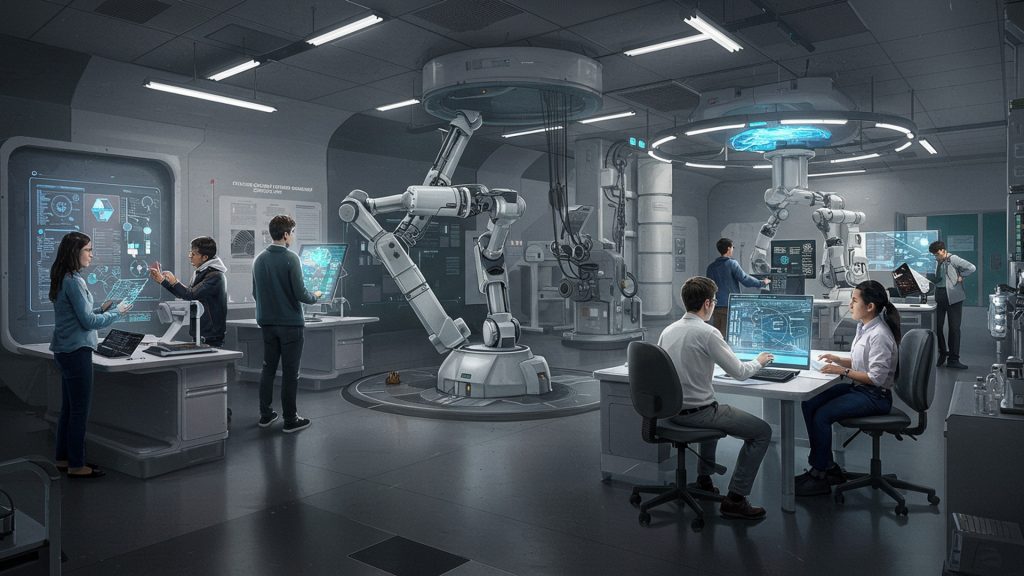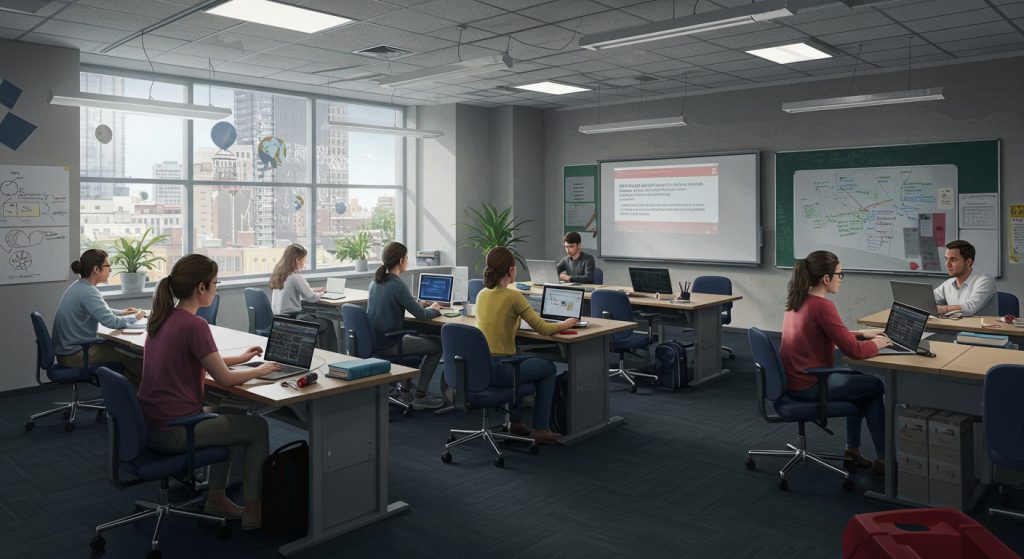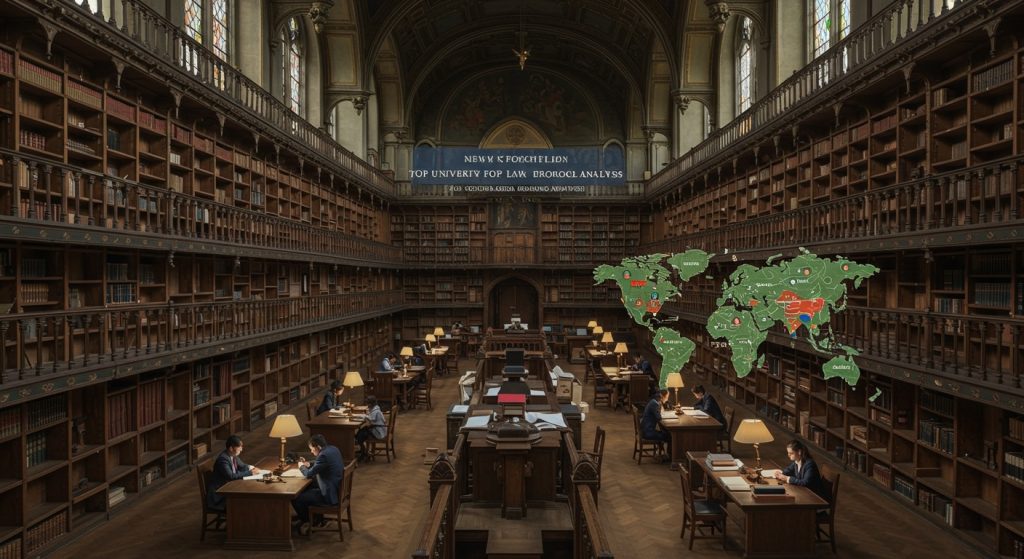Shaping a future where intelligent machines and autonomous systems address humanity’s most pressing challenges, the Massachusetts Institute of Technology stands at the forefront of innovation. Its pioneering work in AI and robotics transcends theoretical boundaries, actively developing breakthroughs from explainable AI models that optimize renewable energy grids to agile robotic systems designed for environmental monitoring and disaster response. Researchers at MIT are not merely advancing algorithms and hardware; they are meticulously crafting the foundational technologies for sustainable global development, integrating ethical considerations into AI-driven material discovery and developing collaborative robots that enhance human potential while mitigating ecological impact. This relentless pursuit of knowledge redefines the symbiosis between humanity and machine intelligence, ultimately forging a more resilient and equitable world.

Understanding the Building Blocks: AI and Robotics
Ever wondered how the futuristic technologies you see in movies are becoming real? It all starts with two powerful fields: Artificial Intelligence (AI) and Robotics. At institutions like the Massachusetts Institute of Technology, these aren’t just buzzwords; they’re tools being honed to build a better tomorrow.
- Artificial Intelligence (AI)
- Machine Learning (ML)
- Deep Learning (DL)
- Robotics
Think of AI as the ‘brain’ of a computer system. It’s the ability of machines to perform tasks that typically require human intelligence, like learning, problem-solving, decision-making. understanding language.
A core part of AI, ML is where computers learn from data without being explicitly programmed. Imagine showing a computer thousands of pictures of cats. it learns to identify a cat on its own! This power to learn and adapt is what makes AI so revolutionary.
A more advanced form of ML, inspired by the structure of the human brain (neural networks). It’s great for complex tasks like image recognition, natural language processing. even generating new content.
If AI is the brain, then robotics is the ‘body’ – the design, construction, operation. use of robots. Robots are physical machines that can sense their environment, process insights. perform actions. They can be anything from a factory arm assembling cars to a tiny drone exploring a hazardous area.
The magic truly happens when AI and Robotics combine. AI gives robots the intelligence to perceive, comprehend. make decisions, transforming them from simple automated machines into smart, adaptable helpers capable of tackling complex, real-world challenges. This synergy is a major focus of research at the Massachusetts Institute of Technology.
MIT’s Vision: AI for a Greener Planet
The Massachusetts Institute of Technology (MIT) isn’t just about cutting-edge tech; it’s deeply committed to using that tech to solve humanity’s biggest problems, especially climate change and environmental sustainability. Here’s how AI from MIT is paving the way for a greener future:
- Climate Modeling and Prediction
- assess vast datasets of climate insights (temperature, ocean currents, atmospheric CO2 levels).
- Predict extreme weather events with greater accuracy, helping communities prepare.
- grasp complex climate feedback loops, giving scientists a clearer picture of future scenarios.
- Optimizing Energy Systems (Smart Grids)
- MIT’s AI research is developing systems that can predict energy demand and supply fluctuations, especially from intermittent sources like solar and wind.
- These ‘smart grids’ can automatically re-route power, store excess energy. even tell your home appliances when it’s cheapest and greenest to run.
- One example is the MIT Energy Initiative, which explores solutions for a sustainable energy future, often leveraging AI to optimize complex energy systems.
- Precision Agriculture
- Crop Monitoring
- Resource Optimization
- Yield Prediction
- Sustainable Material Discovery
- AI can rapidly sift through millions of potential chemical compounds and structures, identifying candidates for new batteries, biodegradable plastics, or efficient catalysts.
- This speeds up the research process by years, accelerating the path to a circular economy where materials are reused and recycled more effectively.
AI models are far more sophisticated than traditional methods. Researchers at the Massachusetts Institute of Technology are using advanced AI to:
This helps policymakers make informed decisions to mitigate climate change effects.
Imagine an energy network that knows exactly how much power is needed where and when, minimizing waste and maximizing renewable energy use.
Growing food sustainably for a growing population is crucial. AI offers incredible solutions:
AI-powered drones and sensors can assess individual plants, detecting disease, nutrient deficiencies, or pest infestations early.
By precisely targeting water, fertilizer. pesticides only where needed, AI reduces waste and environmental impact.
AI helps farmers predict harvests, leading to more efficient planning and less food waste.
This isn’t just theory; these technologies are being tested and deployed globally, many with roots in research from the Massachusetts Institute of Technology.
Developing new materials that are eco-friendly, durable. cost-effective is a huge challenge.
Robotics Revolutionizing Sustainable Industries
While AI provides the intelligence, robotics gives us the physical agents to enact change. The Massachusetts Institute of Technology is at the forefront of designing robots that can work in harsh environments, perform precise tasks. contribute directly to environmental sustainability.
- Environmental Monitoring and Conservation
- Ocean Drones
- Aerial Drones
- Soil and Water Sampling
- Waste Management and Recycling
- Automated Sorting
- Hazardous Waste Handling
- Sustainable Manufacturing and Construction
- Precision Assembly
- Additive Manufacturing (3D Printing)
- Automated Construction
- Disaster Response and Recovery
- Search and Rescue
- Environmental Cleanup
Robots can go where humans can’t or shouldn’t, providing invaluable data:
Autonomous underwater vehicles (AUVs) developed by MIT researchers can monitor ocean health, track pollution plumes, map coral reefs. study marine life without disturbing ecosystems.
Equipped with AI, drones can survey vast forests to detect illegal logging, monitor wildlife populations, or assess damage after natural disasters.
Ground robots can collect environmental samples from remote or contaminated areas, providing data for conservation efforts.
The sheer volume of waste is a global crisis. Robots offer a solution:
Robotic arms with advanced AI vision systems can quickly and accurately sort different types of recyclables (plastics, metals, paper) much faster and more efficiently than humans, improving recycling rates and purity.
Robots can safely handle toxic or radioactive waste, protecting human workers and ensuring proper disposal.
Robots can make production processes greener:
Robots can perform tasks with extreme precision, reducing material waste and optimizing resource use in manufacturing.
Robotic 3D printers can create complex parts layer by layer, using only the necessary material, minimizing waste compared to traditional subtractive manufacturing.
Robots can build structures more efficiently, potentially using sustainable materials and reducing construction waste.
When environmental disasters strike, robots can be lifesavers:
Robots can navigate collapsed buildings or contaminated areas to find survivors or assess damage, reducing risk to human first responders.
From oil spill recovery to containing chemical leaks, robots can perform dangerous cleanup tasks more safely and effectively.
The work at labs like the Computer Science and Artificial Intelligence Laboratory (CSAIL) at the Massachusetts Institute of Technology often leads to these kinds of innovative robotic solutions.
The Ethics of Innovation: Ensuring a Just Future
As exciting as these breakthroughs are, a crucial part of the discussion at the Massachusetts Institute of Technology and beyond is the ethical development and deployment of AI and Robotics. A sustainable global future isn’t just about technology; it’s about people and fairness.
- Addressing Bias in AI
- MIT researchers are actively working on methods to identify and mitigate bias in algorithms, ensuring that AI systems are fair and equitable in their decisions. For example, an AI designed to optimize resource allocation must do so without discriminating against certain communities.
- The Future of Work
- The focus isn’t just on replacing jobs but on creating new ones and enhancing human capabilities. MIT encourages discussions and research into how society can adapt, emphasizing education, reskilling programs. the development of new roles where humans and AI collaborate effectively.
- Accessibility and Equity
- This means developing AI and robotic solutions that are affordable, easy to use. adaptable to diverse global contexts. It also involves ensuring that the benefits of sustainable technology reach vulnerable communities who are often most impacted by environmental degradation.
- Transparency and Accountability
- Research at the Massachusetts Institute of Technology often explores “explainable AI” (XAI) – making AI models more transparent so we can grasp their reasoning and hold them accountable.
AI systems learn from the data they’re fed. If that data reflects existing societal biases (e. g. , historical inequalities), the AI can learn and perpetuate those biases.
As robots and AI take on more tasks, there’s concern about job displacement.
Ensuring these powerful technologies benefit everyone, not just a privileged few, is paramount.
Understanding how AI makes decisions is vital, especially in critical applications.
These ethical considerations are not footnotes; they are integral to MIT’s approach to pioneering AI and Robotics for a truly sustainable and just global future.
Beyond the Lab: Real-World Impact and Future Horizons
The innovation happening at the Massachusetts Institute of Technology isn’t confined to laboratories; it’s actively shaping our world. Let’s look at how some of these ideas are making a tangible difference and what the future holds.
Case Study: AI for Urban Sustainability at MIT
Consider the challenge of making cities greener. Researchers at MIT’s Senseable City Lab, for instance, are leveraging AI and sensor data to grasp urban dynamics in unprecedented detail. They’ve deployed sensors across cities to monitor everything from air quality and traffic flow to waste generation and energy consumption. Using AI, they assess this massive influx of data to:
- Identify “hot spots” of pollution and recommend targeted interventions.
- Optimize public transport routes and traffic light timings to reduce congestion and emissions.
- Design more efficient waste collection routes, reducing fuel consumption and operational costs.
- Inform urban planners on how to design more walkable, bikeable. green cities.
This isn’t just about making a city ‘smart’; it’s about making it inherently more sustainable and livable for its residents. The insights gained from these projects, often conducted in collaboration with city governments, provide actionable takeaways for urban development worldwide.
What You Can Do: Your Role in a Sustainable Future
These breakthroughs from the Massachusetts Institute of Technology aren’t just for scientists and engineers. You, too, can be a part of this sustainable revolution:
- Stay Curious and Learn
Dive deeper into AI and robotics. There are countless free online courses (many from MIT itself, like those on edX) that can teach you the basics of coding, AI concepts. machine learning. Understanding these technologies is the first step.
# Example of a simple AI concept: a basic 'if-else' decision temperature = 28 # degrees Celsius if temperature > 25: print("It's hot! Consider turning on the smart fan.") else: print("Temperature is comfortable.") As you encounter new technologies, ask questions. How was this AI trained? Who benefits from this robot? What are the potential ethical implications? Being a thoughtful consumer and citizen is powerful.
If you’re passionate about technology and sustainability, consider a career in AI, robotics, environmental science, or engineering. The world needs your ideas and passion to tackle future challenges. Institutions like the Massachusetts Institute of Technology are always looking for bright minds.
Support policies and companies that prioritize ethical and sustainable technological development. Your voice matters in shaping the direction of innovation.
The journey towards a sustainable global future is complex. with the relentless innovation from institutions like the Massachusetts Institute of Technology, powered by the incredible potential of AI and Robotics, we have powerful tools at our disposal. It’s a future where technology serves humanity and the planet, ensuring a thriving world for generations to come.
Conclusion
MIT’s pioneering work in AI and robotics, from developing advanced climate models at the Computer Science and Artificial Intelligence Laboratory (CSAIL) to creating agile robots for environmental monitoring, fundamentally reshapes our approach to global sustainability. It’s clear these innovations are not just theoretical advancements but practical tools for tackling urgent challenges like climate change and resource scarcity. My personal tip for anyone inspired by these breakthroughs is to actively engage with the ongoing conversation. Consider exploring online courses in AI ethics or contributing to citizen science projects that leverage machine learning for ecological data analysis. For instance, understanding how AI optimizes energy grids, a current trend, requires both technical insight and a grasp of its societal implications. This proactive involvement, rather than passive observation, is crucial. Ultimately, the future MIT envisions — one where technology serves as a powerful ally for a sustainable planet — is within our collective grasp. Let’s embrace this era of intelligent innovation, remembering that our individual curiosity and commitment are the true drivers of a resilient global future.
More Articles
How Online Learning Transforms Your Career: A Guide for Busy Professionals in 2025
Exploring American Universities: A Student’s Path to Global Opportunities in 2025
Unlocking Innovation: UCL’s Research Impacting Global Challenges in 2025
Choosing Your MBA Specialization Wisely: A Practical Guide for Future Business Leaders
FAQs
What kind of cool AI stuff is MIT working on right now?
MIT is pushing boundaries in AI, developing everything from advanced machine learning algorithms that can predict climate patterns to AI systems that optimize energy grids and design more efficient materials. They’re also making strides in areas like natural language processing and computer vision to help robots comprehend and interact with the world better.
How do these AI and robotics innovations actually help us build a more sustainable future?
A big part of MIT’s focus is applying these technologies to environmental challenges. This means using AI to manage renewable energy sources, design sustainable infrastructure, monitor ecosystems. even optimize supply chains to reduce waste. Robotics can then assist in tasks like precision agriculture, environmental monitoring, or hazardous clean-up, all contributing to a healthier planet.
Will these high-tech solutions really make a difference for everyone around the globe?
Absolutely. The aim is to create scalable solutions that can address global challenges. For instance, AI-driven agricultural tools can boost food security in different regions. robotic systems can aid in disaster response or provide access to education and healthcare in underserved areas. The goal is to develop technologies that benefit communities worldwide, not just in developed nations.
What’s the ultimate vision behind MIT’s work in AI and robotics for the future?
The ultimate vision is to leverage the power of AI and robotics to create a resilient, equitable. sustainable world. It’s about designing intelligent systems and machines that can help solve humanity’s most pressing problems, from climate change and resource scarcity to health and education, ensuring a better quality of life for current and future generations.
How does MIT make sure these powerful new technologies are developed responsibly and ethically?
Ethical considerations are central to MIT’s approach. They emphasize interdisciplinary collaboration, bringing together engineers, scientists, ethicists. social scientists to consider the societal impact of new technologies. There’s a strong focus on developing AI that is fair, transparent. accountable. designing robots that operate safely and respectfully within human environments.
Can you give me a couple of examples of specific projects or breakthroughs?
Sure! One example is AI models that predict extreme weather events with greater accuracy, helping communities prepare better. Another might be soft robots designed for delicate environmental tasks, like monitoring marine life without disturbing it, or autonomous systems optimizing energy usage in smart cities. There’s also work on AI-driven material discovery for next-gen sustainable batteries.
What’s next on the horizon for MIT’s AI and robotics research?
Looking ahead, MIT researchers are focused on creating more adaptive, collaborative. human-centric AI and robotic systems. This includes developing AI that can learn continuously from less data, robots that can seamlessly work alongside people in complex environments. integrated systems that combine multiple AI and robotics capabilities to tackle even grander challenges.



